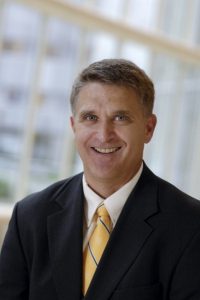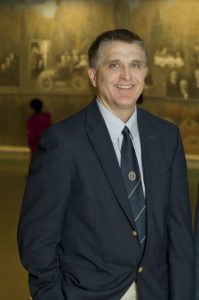David Farley, M.D. – Q&A with a legendary Teacher of the Year awardee
David Farley, M.D. (S ’94), could fill a couple of trophy cases with his 19 Teacher of the Year Awards for the General Surgery Residency Program, Department of Surgery and Subspecialties and Mayo Clinic School of Medicine. He also has a Distinguished Educator Award and Mayo Medical School Faculty Service Award. He says this award-abundance is due to the extra time he has had with residents as the Division of General Surgery’s residency program director for 15 years. The more than 500 general surgery students he’s helped trained say otherwise.
Dr. Farley is a general surgeon in the Department of Surgery at Mayo Clinic in Rochester. He joined the Mayo Clinic staff in 1994 and is associate director of the Mayo Clinic Multidisciplinary Simulation Center and a professor of surgery. He teaches general surgery — diseases of the gallbladder, breast, thyroid gland, abdominal wall and others using open, laparoscopic and robotic surgery.
How do you know when you’ve done a good job teaching?
I know when trainees perform well on assessment or with the care of our patients. For many years I thought I was a great speaker and educator, but after giving what I thought as a “great lecture,” someone will ask a question that shows they didn’t understand the material I just covered. Educators, and especially me, have to accept the fact that lectures and PowerPoint presentations are not the perfect way to teach adults. Research shows students need hands-on learning, especially for surgical training. They won’t learn everything the first time and may need multiple times to grasp it. You don’t always know what they’ve learned until quiz time.
What’s rewarding about teaching?
Former students often send me notes saying things like, “I felt like you were watching over my shoulder today.” They were challenged, and they relied on what we have taught them to do. That’s really rewarding. Regardless of accolades or awards, my hope is to teach every minute of the day in the quest for creating better surgeons.
I tell students that the needs of the patient really do come first, but if that patient has a daughter or granddaughter, we have to remember the needs of the patient include teaching the next generation of surgeons. It takes extra time and effort and may not generate immediate return for Mayo, but it’s one of the most important things we do.
What’s your teaching style?
I think I am patient, forgiving, relatively flexible and understanding. I talk through things before doing them. My dad always commented, “The mother of learning is repetition,” and I believe that.
How has your teaching changed over the years?
Education literature has convinced me that adults learn better using their hands, being engaged with simulation and — most importantly — with multiple repetitions. In our simulation curriculum, we give multiple experiences so students can fail and then succeed. We didn’t have that option in the past.
Today students spend much less time at the hospital due to duty-hour changes. They come to surgical training with a little less breadth of experience, so we have to be better at helping them learn.
Another big change since the ‘90s is the internet. Now, the night before a student is going to help a staff surgeon with a procedure, he or she can go on our website and look at videos, images, quizzes and gaming experiences to practice. I think it makes for a better teaching environment when the student is better prepared.
How have students changed over the years?
Medical students today get greater diversity of experiences — rotations in Haiti and Guatemala, a week in pediatric cardiac infectious diseases, medical genetics and the like. I didn’t get to do that kind of thing as a student, but we did get three months of surgery, three months of internal medicine, and the same for pediatrics and OB-GYN. Today’s students have a great breadth of experience but not as much depth in any one area.
Mayo students and trainees are extremely bright, and millennials are really bright. They are fantastic to work with.
Who were your teaching role models?
My parents were both excellent teachers. My mom was an elementary school teacher. My dad was a physical education teacher and football coach.
At Mayo, Jon van Heerden (S ’70) (Emeriti staff) and Mike Saar (GI ’80) (Emeriti staff) were extraordinary teachers and mentors.
Also, my uncle was a private practice doctor in the Twin Cities, and he greatly influenced me. Everybody along the way teaches you something. It’s fun when a teacher makes learning enjoyable.
What do teacher of the year awards mean to you?
I’m not a big awards guy, but they do give a sense of accomplishment. It’s gratifying to be acknowledged for the effort and making a difference in students’ lives.
Student comments:
“I have never seen a person who is dedicated to teaching young trainees like Dr. Farley. He is innovative in his approach to surgical education and making residents better. We’re privileged and honored to have the opportunity to learn from him.”
“He’s an educator like no other. He goes above and beyond the call of duty with the hopes of making great surgeons out of us. The educational videos he makes are gold.”
“Dr. Farley lives and breathes resident surgical education, and it permeates everything he does. His passion for education is unparalleled.”


